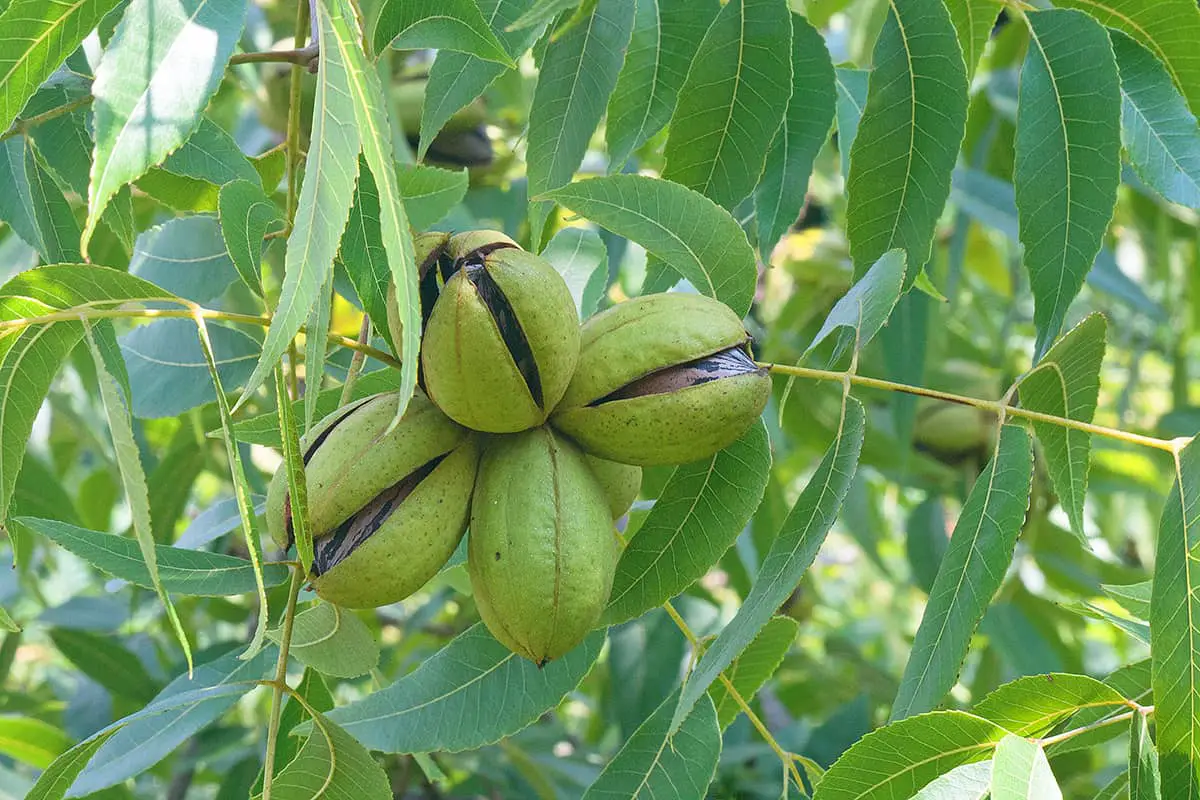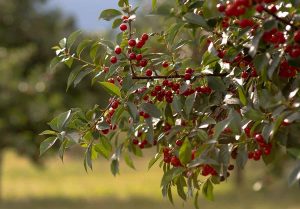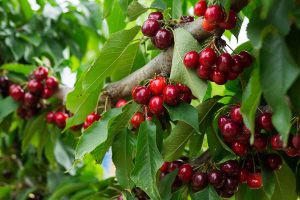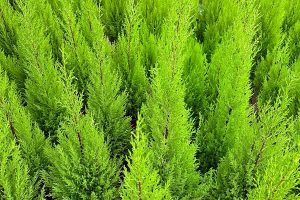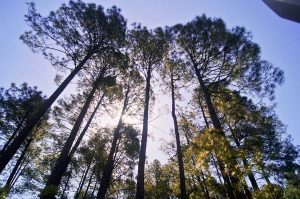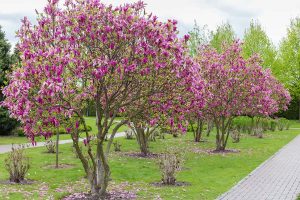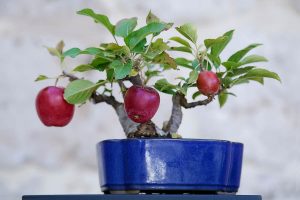Nut-bearing trees are a good alternative to fruit trees if you are interested in harvesting edible foods from your garden, and they also offer other advantages, such as providing shade, privacy, or visual interest to the landscape.
Here, we explore a variety of nut trees that are suitable for growing in numerous different climates with various care requirements.
Table of Contents
Nut-Bearing Trees
Almond Tree
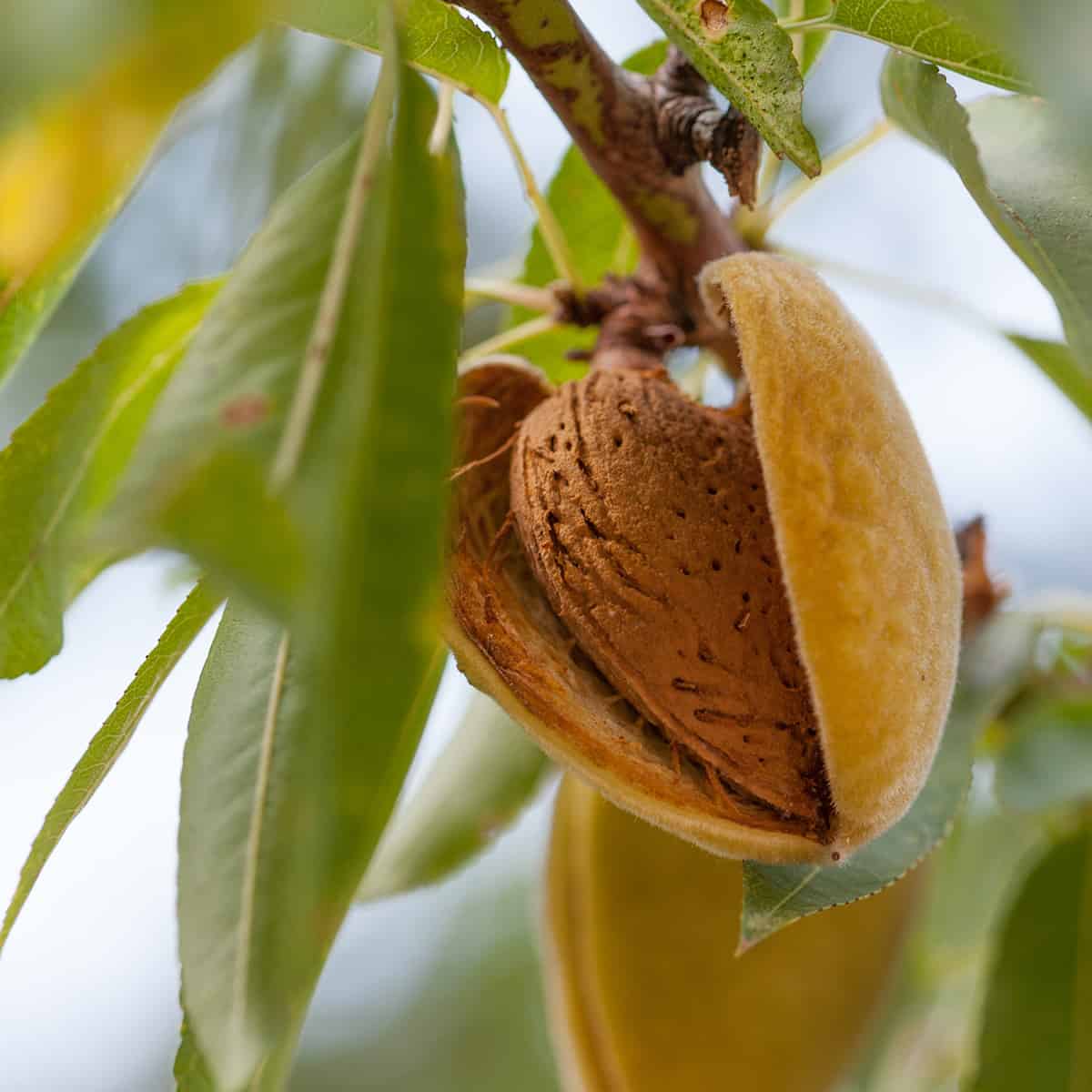
- Botanical name: Prunus dulcis
- Family: Rosaceae
- USDA hardiness zones: 7 – 9
- Mature height: 10 to 15 feet
- Mature spread: 10 to 15 feet
The almond tree is native to Iran and the surrounding countries in the Middle East, where it thrives in warm and dry climates. It is stunning as an ornamental tree since it has a wide-spreading, open canopy, upon which pink blossoms emerge in early spring before the arrival of the leaves.
The flowers are followed by olive green colored fruits, which contain edible almond nuts. The leaves of this tree are pale green through spring and summer, fading to a burnt orange in fall before dropping to the ground. Almond trees require cross-pollination in order to produce fruits, so if you are growing these trees for harvesting nuts then you should plant a minimum of two different almond varieties.
As almond trees prefer hot and dry climates, they fare well in California, where almond farming has become an important commercial market. There are over 7000 almond farmers in this state alone, and these account for 82% of the world’s harvested almonds.
If you are growing almond trees at home, ensure they are in a position of full sun and are kept in well-draining soil. Almond trees will survive in poor soils and periods of drought, however, they prefer average soils which have medium moisture levels.
Macadamia Tree
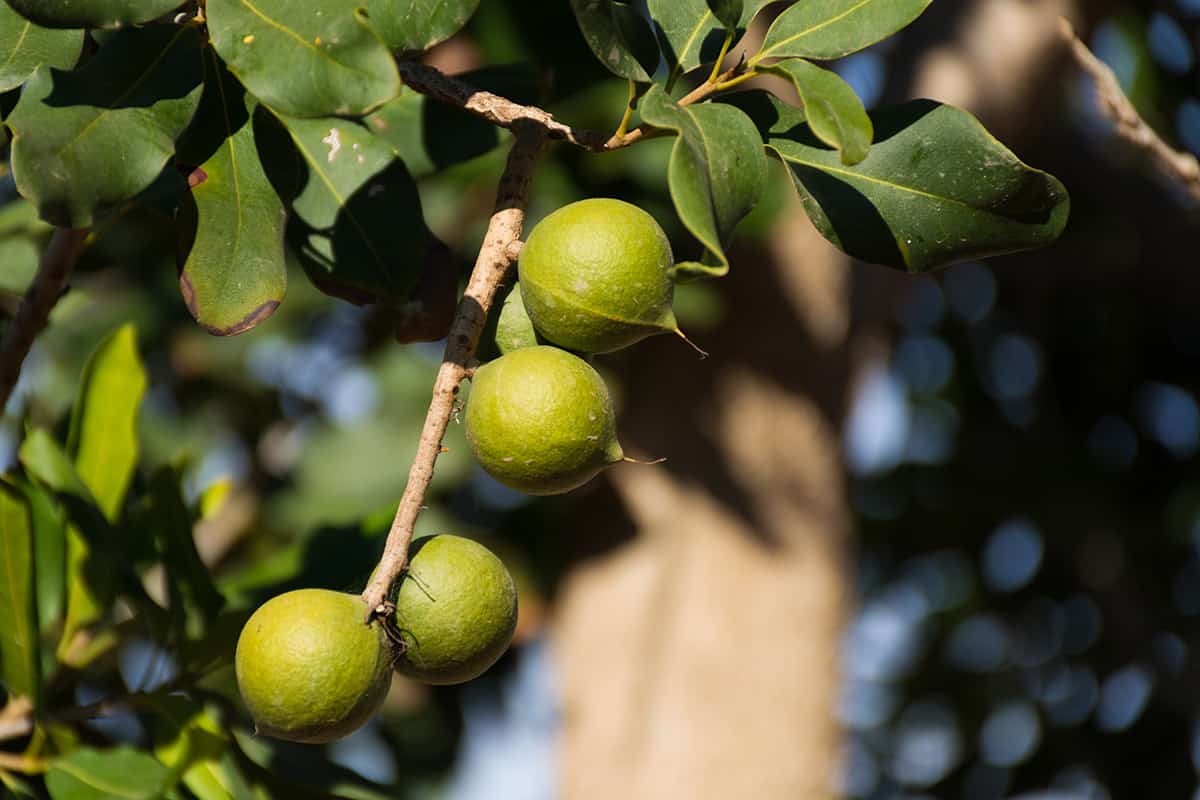
- Botanical name: Macadamia integrifolia
- Family: Proteaceae
- USDA hardiness zones: 9 – 11
- Mature height: 30 to 50 feet
- Mature spread: 20 to 40 feet
The macadamia tree produces macadamia nuts, which were an important source of food for Aboriginal Australians long before the nuts were discovered by Europeans exploring Australia in the 1820s. The macadamia tree is native to Queensland in Australia but was introduced to Hawaii in 1837.
For many years the trees were cultivated on a mass scale in Hawaii for the production of macadamia nuts, however, since the early 2000s, South Africa has taken the lead as the largest producer of these nuts in the world.
The macadamia tree is a broadleaf evergreen with glossy ovate leaves. It produces dangling racemes of pale pink blossoms in winter and spring, which give way to the fruits. Macadamia nuts are smooth and cream-colored, but on the tree, they are encased by a hard shell. These shells are so tough that they cannot be opened by hand.
Macadamia trees grow best in hot climates, with plenty of moisture. They thrive in medium to wet soils, however, they can survive periods of drought once well established. As well as being cultivated for their nuts, these trees also make good specimen trees because they are quite showy, and they are also excellent at providing shade due to their tall, wide canopy. The macadamia tree is not tolerant of frost and should only be grown in USDA hardiness zones 9 through to 11.
Pecan Tree
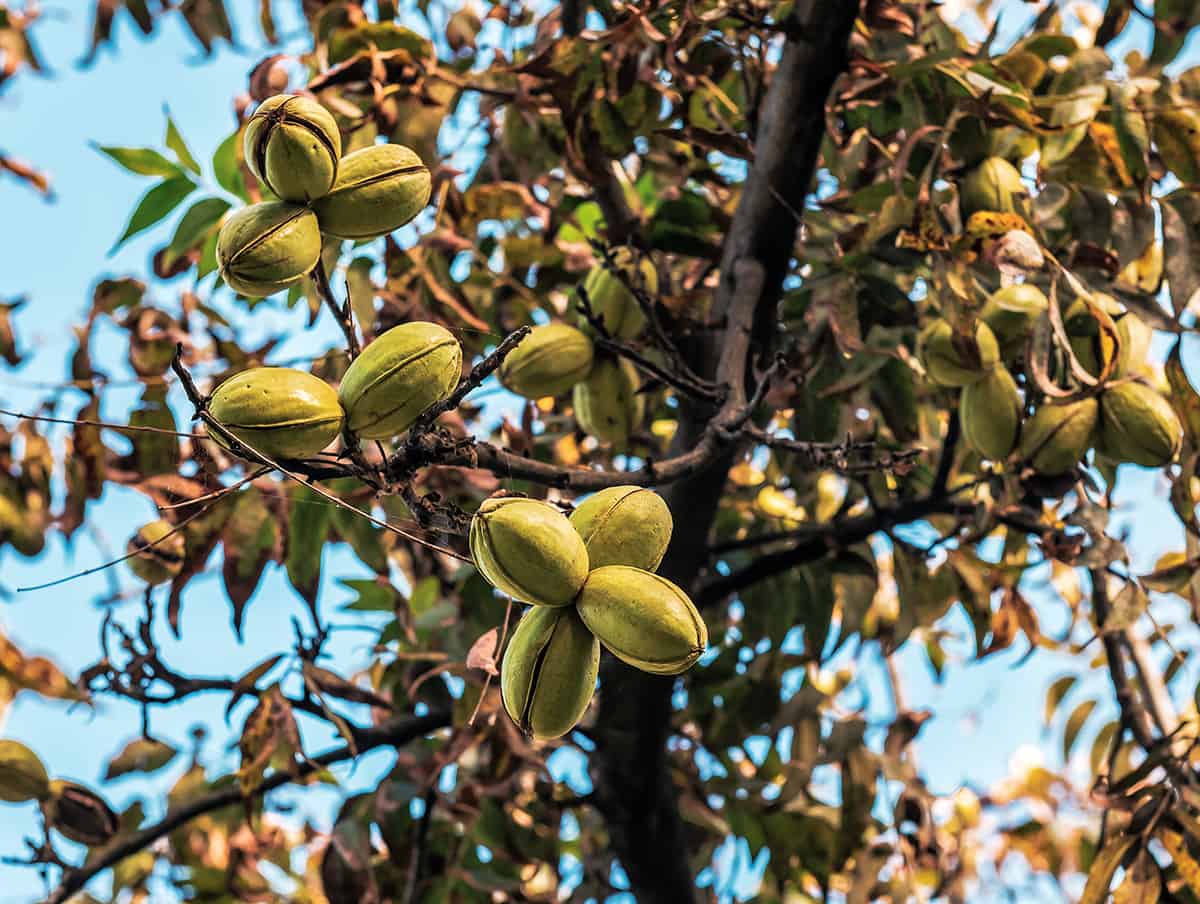
- Botanical name: Carya illinoensis
- Family: Juglandaceae
- USDA hardiness zones: 5 – 9
- Mature height: 75 to 100 feet
- Mature spread: 40 to 70 feet
The pecan tree is a North American plant, growing natively in northern Mexico and the southern United States, primarily along the Mississippi river. The tree is also known as the hardy pecan tree and the Illinois pecan tree. It produces edible pecan nuts, which are popularly used to make pecan pie and praline.
Mexico is responsible for half of the world’s pecan production, and these trees are also widely cultivated for their nuts in Texas, Georgia, and New Mexico. The pecan tree is the state tree of Texas, and the nut it produces is the state nut for Texas, California, Arkansas, and Alabama.
The pecan tree is deciduous, and it works well as a shade tree as well as a fruiting tree. It can be grown from seed and will take around 10 years to reach the stage where it produces nuts. The trees produce green pinnate leaves in spring, which develop to bright yellow-green in summer before fading to brown and falling to the ground before winter.
The flowers of the tree emerge in spring and are not especially noticeable. They give way to pecan nuts which are enclosed in husks. The husks split open to reveal the nuts when they ripen in the fall. The tree should be grown in full sun, in well-draining soil that is moderately moist. Plant the pecan tree where you intend to keep it because these trees have very long tap roots which make them difficult to transplant.
Pinyon Pine Tree
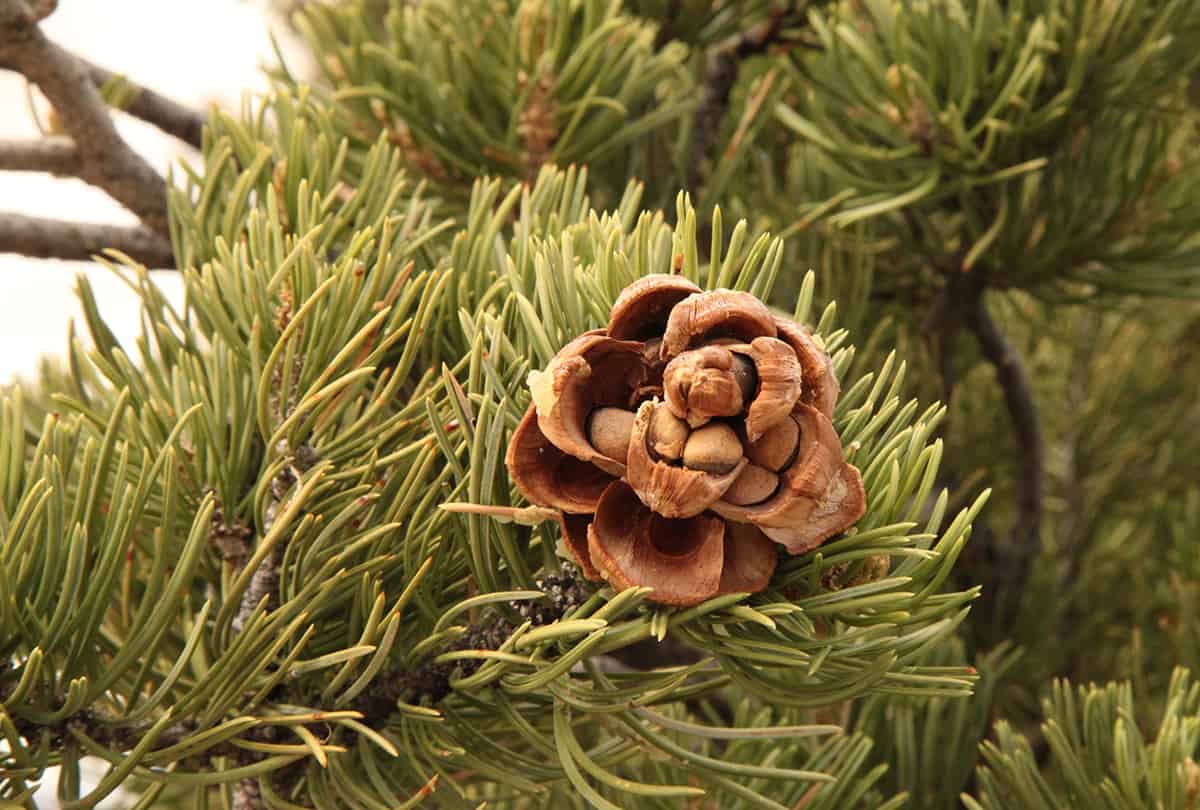
- Botanical name: Pinus edulis
- Family: Pinaceae
- USDA hardiness zones: 3 – 8
- Mature height: 10 to 40 feet
- Mature spread: Up to 10 feet
Pine nuts are produced by the pinyon pine tree, which is also known as the Colorado pine tree, the Colorado pinyon, and the two-needle pinyon. It is native to North America, from Utah and Colorado through to Arizona, New Mexico, Oklahoma, and Texas. It is the state tree of New Mexico and is the most commonly found tree on the southern edge of the Grand Canyon National Park.
The pine nuts gathered from this tree are the seeds of the plant, and they are expensive to buy in stores because they are difficult to harvest and take a long time to produce. Harvesting occurs in September and October, by smashing them out of the pine cones and separating them.
The nuts are ready to harvest up to 2 weeks before the cones open, which adds to the difficulty of this task. Once removed, they also then need to have their outer coating peeled away before they can be consumed. Pine nuts are popularly used to make pesto or in trail mixes. They are also loved by wildlife, including deer, bears, turkeys, and birds.
Pinyon pine trees are evergreen conifers that are small to medium in size. They are slow growing, with needle-like foliage and cones which take around 2 years to mature. They should be grown in full sun and can survive in various soil types. They prefer moist soil but can survive periods of drought when established.
American Hazelnut Tree
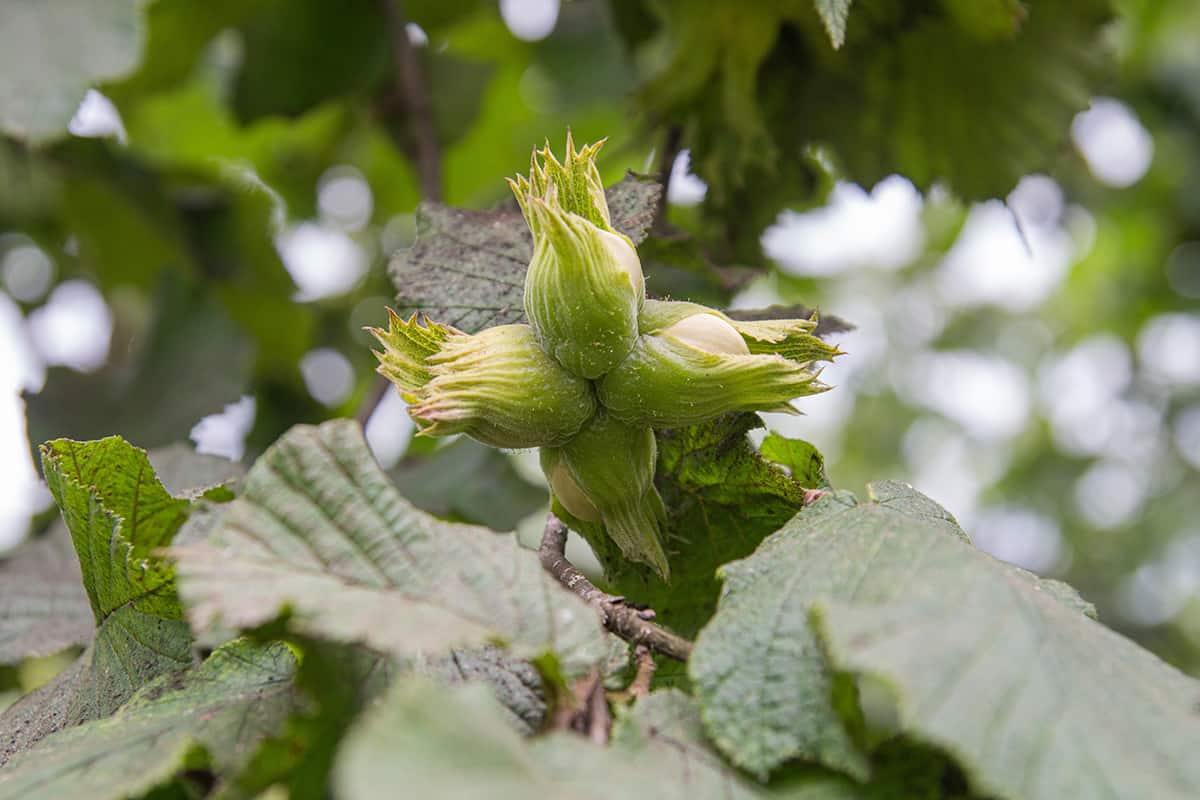
- Botanical name: Corylus americana
- Family: Betulaceae
- USDA hardiness zones: 4 – 9
- Mature height: 15 to 20 feet
- Mature spread: 10 to 12
This native North American tree is also known as the American Filbert, and most commonly takes the form of a medium to large-sized shrub which spreads via suckers. Unless the plant gets thinned out, it can grow to become a dense thicket, which can be useful for creating privacy borders.
It has a fast-growing nature, and will typically gain around 2 feet in height each year until it reaches maturity. The leaves of the hazelnut tree have toothed margins and coarse, hairy stems. The flowers arrive in spring, and on plants that are at least 2 or 3 years old, fruits will follow in the form of hazelnuts. These nuts are typically around half an inch across, and they are enclosed in a hard husk that is covered in hairs.
They will usually have matured by around September or October and can be harvested from the plant when the husks are green. If you allow the husks to develop to a golden brown color while still on the plant, you will find that they become very attractive to local wildlife.
Hazelnut trees and shrubs should be grown in full sun for best nut production, and they should be planted in groups including both male and female plants for cross-pollination. It grows well in moist soils but is also drought tolerant once well established.
Chestnut Tree
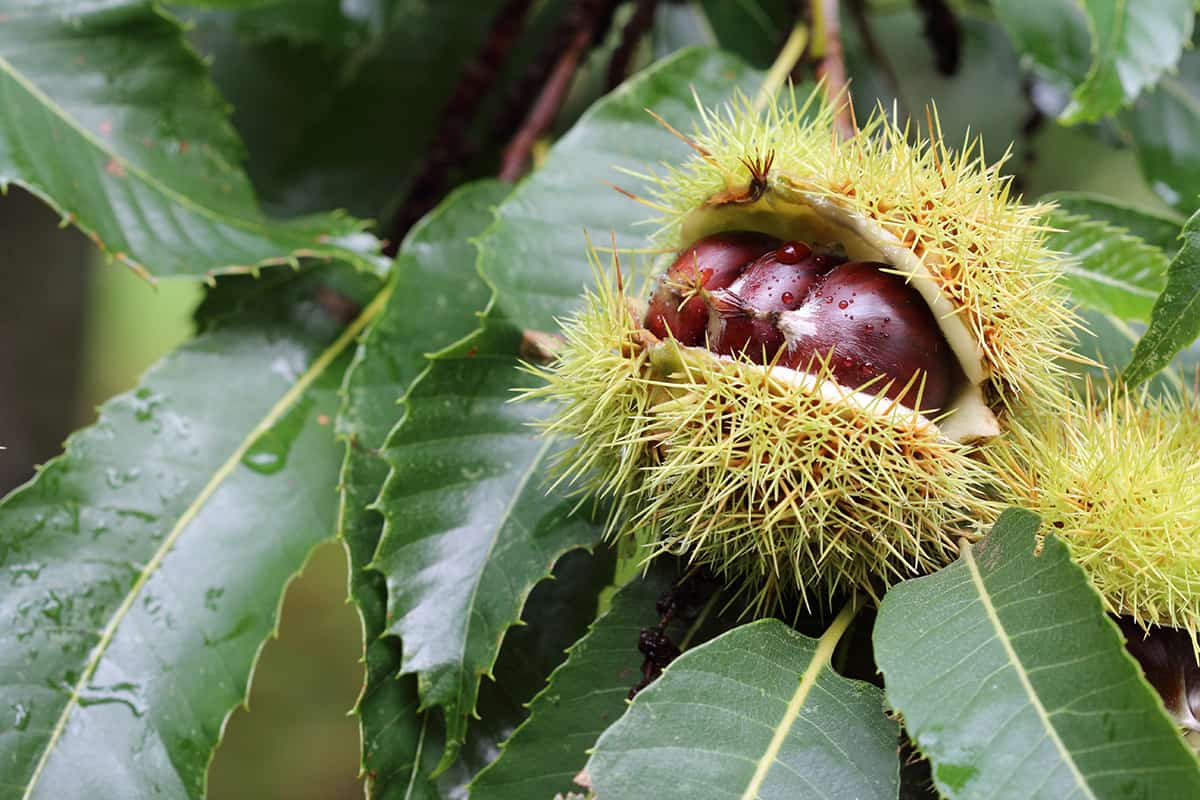
- Botanical name: Castanea sativa
- Family: Fagaceae
- USDA hardiness zones: 5 – 7
- Mature height: Up to 100 feet
- Mature spread: Up to 50 feet
The chestnut tree, also known as the sweet chestnut tree, the European chestnut tree, or the Spanish chestnut tree, is a large, deciduous tree, which produces edible chestnuts. The tree is native to Asia and southern Europe, where it can live to be over 500 years old. The trunk of a mature chestnut tree will reach a considerable size; typically around 7 feet in diameter, though there are some examples of the trunk exceeding 13 feet in diameter.
The foliage of the tree is green and serrated, with leaves developing to intense golden orange in the fall. Catkins can be seen from midsummer onwards, and after cross-pollination, these will give way to seeds enveloped in spiked husks, which deter predators. Each husk will contain anywhere from 3 to 7 seeds, and these are the edible nuts we know as chestnuts. They are most commonly roasted before consumption because their outer skin is quite bitter when fresh.
Chestnut trees should be grown in full sun, in well-draining, moist soils. Once established, the trees are very tolerant of drought. A chestnut tree grown from seed can take as long as 20 years to start producing chestnuts, while those grown from grafting can fruit as early as 5 years of age.
Pistachio Tree
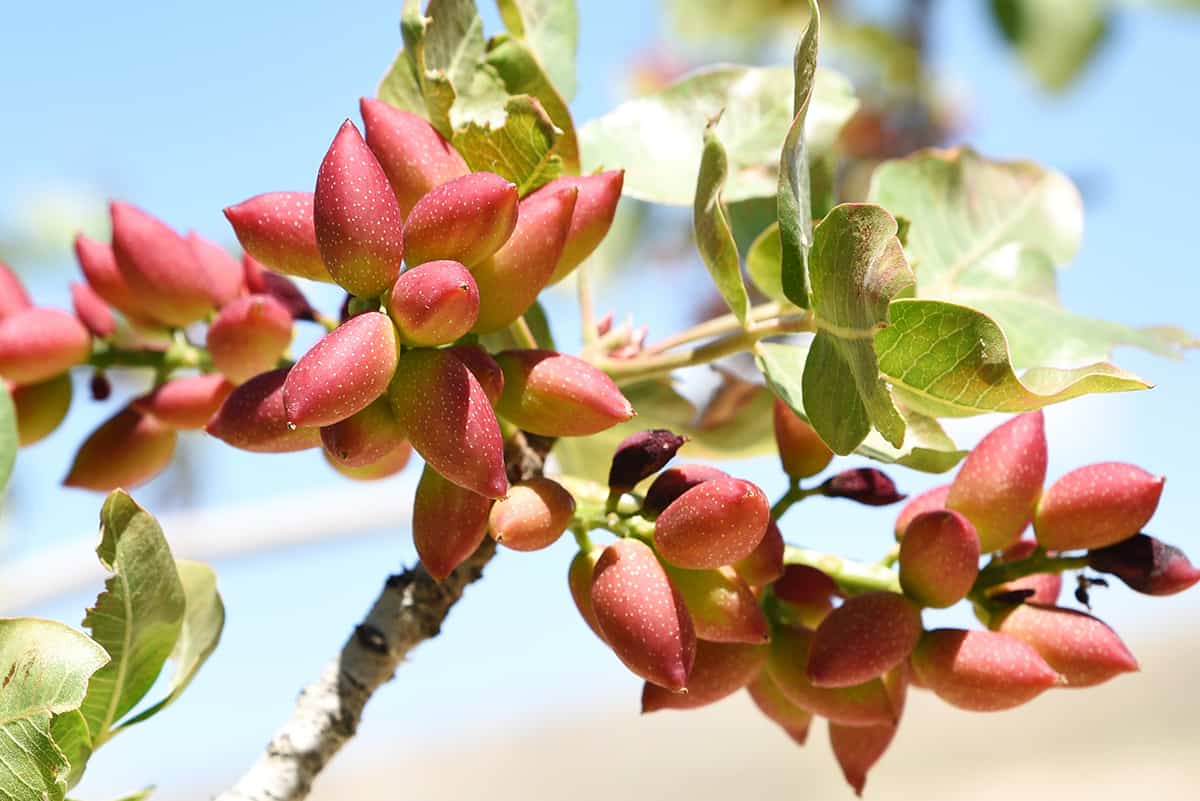
- Botanical name: Pistacia vera
- Family: Anacardiaceae
- USDA hardiness zones: 7 – 11
- Mature height: 25 to 30 feet
- Mature spread: 25 to 30 feet
The pistachio tree is a deciduous plant, native to Asia. It produces pistachio nuts, which are known to have been a popular food as early as 6750 BC. There is evidence showing that these nuts were consumed in modern-day Uzbekistan in the Bronze Age. The trees were brought to Europe from Asia by the Romans and widely cultivated across temperature regions.
The pistachio tree lives to around 300 years old and will begin offering significant harvests of nuts at around 7 years of age. It will reach prime production after around 20 years. Today, the biggest producers of pistachio nuts for commercial purposes are Turkey and the United States, with the US supplying over half of the world’s production of pistachio.
The pistachio tree is easy to grow and will thrive in full sun with soil that is either dry or moist, but not wet. To bear nuts, the female pistachio tree needs to be cross-pollinated with a male pistachio tree. It is the female tree that will produce the nuts.
Black Walnut Tree
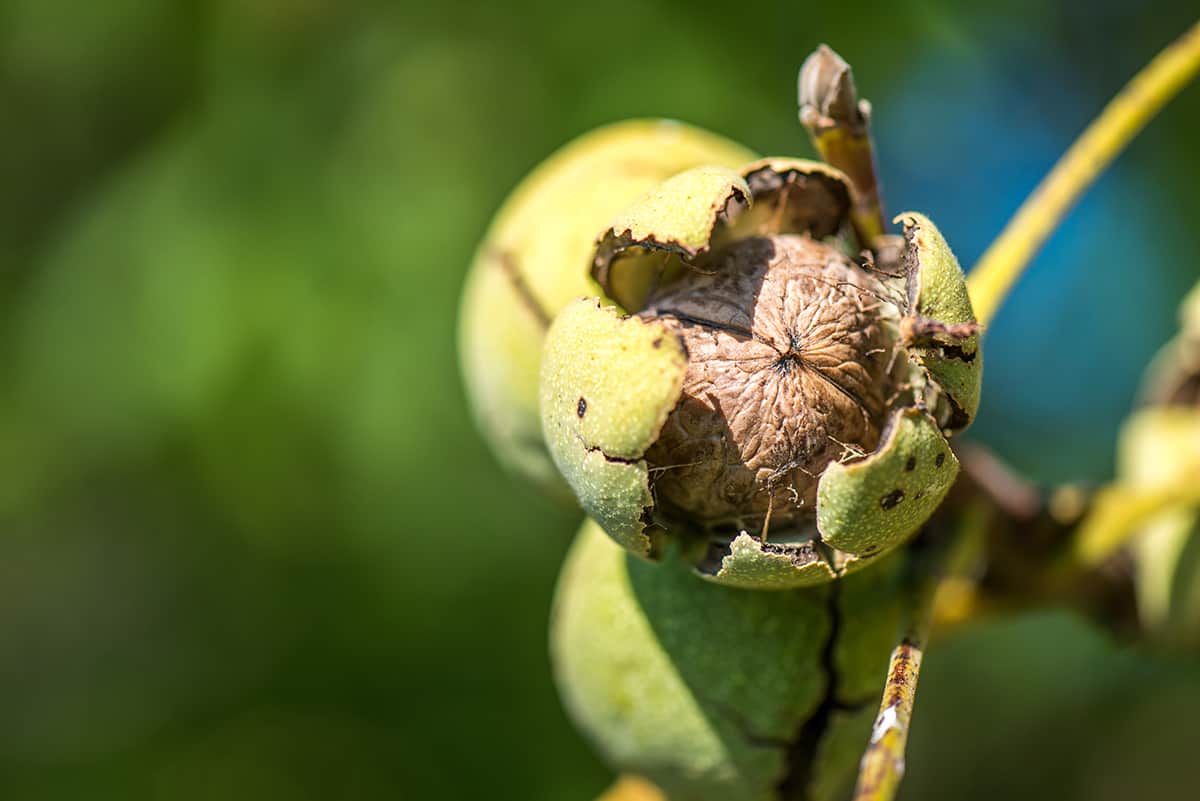
- Botanical name: Juglans nigra
- Family: Juglandaceae
- USDA hardiness zones: 4 – 9
- Mature height: Up to 100 feet
- Mature spread: Up to 100 feet
The black walnut tree is native to North America, growing from Ontario in Canada down to Florida and Texas in the United States. It is an enormous specimen, with wide-reaching branches that form a rounded canopy. Pinnate leaves in fresh green emerge towards the end of spring, along with pendulous catkins on male trees, and spiked flowers on female trees.
Following cross-pollination, the female tree produces edible walnuts enveloped in green husks. As they mature, the husks fade to brown and drop to the ground, where they will be gathered by squirrels and other wildlife. A healthy harvest will begin to be produced by the black walnut tree once it reaches around 20 years in age.
As well as being cultivated for their edible nuts, these trees are also grown for their sought-after hardwood. The wood of the black walnut tree demands a high price and is very valuable in carpentry for making furniture and flooring.
The black walnut tree should be grown in full sun. It thrives in well-draining soils that are consistently moist, preferring to grow naturally nearby to riverbeds and other areas where the soil tends to be moist and rich.
